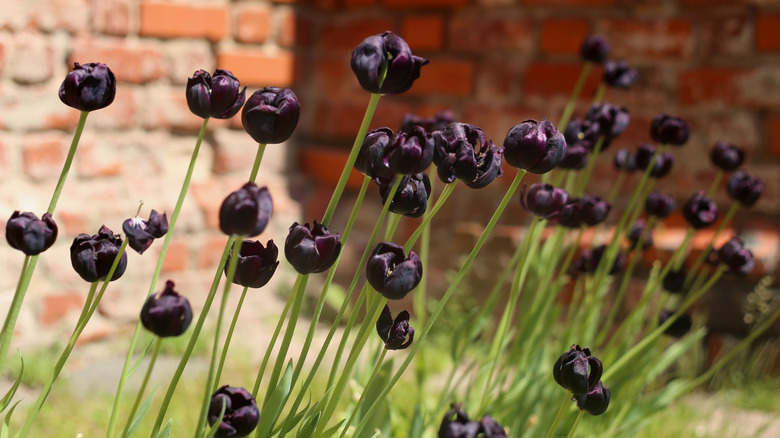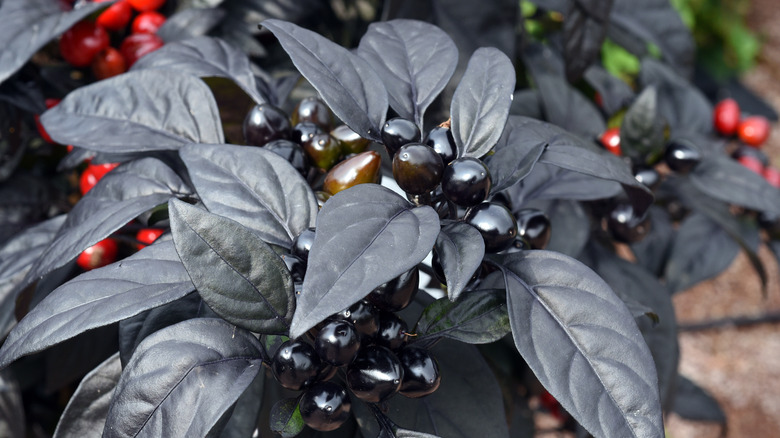How To Create A Striking Goth Garden In Your Yard
Gardening is all about mood. Gardens can be cheery and bright with lots of colorful, vibrant flowers or neutral and no-nonsense with simple succulents and rocky terrain. Goth gardens — those with a dark and romantic air– are all about setting a more mysterious mood. Recently, goth gardens have been trending in backyards.
Goth, of course, has always symbolized counter-culture, dating back to the original Goths, the Germanic people who fought the Romans in 300-400 AD and contributed to their downfall. In the Victorian era, goth was a vibe in spooky novels like Frankenstein and Dracula, and then it was embraced again by punk and alternative rock bands in the 1980s. Gothic stories, like Netflix's Wednesday series, continue to fascinate us today, so goth isn't likely to go away anytime soon. It's no wonder many people want to bring a little goth aesthetic to the garden.
Like gothic novels, goth gardens are darkly romantic landscapes filled with dramatic blooms sometimes adorned with spooky names. They are about flipping the script on what a garden can be and embracing the unique and unusual. Instead of bright colors, goth gardens showcase dark blooms in deep shades of gray, purple, magenta, or even black, like black tulips or black lilies. Dark ground covers like black mondo grass set the mood, too. If you want to grow your own goth garden, whether large or small, we've got the best tips.
Dark flowers in goth gardens often still need sun
While the shadowy gothic figures of novels and movies might prefer dark corners, the blooms of your goth garden will probably crave sunlight. Black tulips might look like one of the best plants for a shade garden, but they actually need lots of sun. 'Queen of Night' tulips are nothing new. They were even the focus of the 1850 novel by Alexandre Dumas about love and obsession, The Black Tulip. They need full sun and thrive in USDA Plant Hardiness Zones 3 to 8.
Some dark blooms prefer a little bit of both sun and shade. 'Night Rider' lilies crave full sun, but tolerate partial shade, especially if the shade is focused at the plant's base to help keep bulbs cool. 'Night Rider' lilies, which thrive in zones 3 to 9, are fairly easy to grow. Every year, they unfurl dramatic dark blooms that look black in different lights.
If you want a shady goth garden, then choose plants like the 'Black magic' hellebore. This particular herbaceous perennial with black showy petals prefers shadowed corners of the garden. Eventually, hellebores might need to be divided to produce more blooms. If you want to know how to transplant helleborus, do so gently and not often. Consider, too, the shade-loving black mondo grass (Ophiopogon planiscapus), which does well with less than two hours of sunlight a day. Every summer, it sprouts white blooms as a contrast to its dark leaves.
Add in edible goth plants for a fun surprise
While you might assume goth gardens should include poisonous plants, like in the children's book, Millie Fluer's Poison Garden – a fun twist instead might be growing dark vegetables or herbs that can actually be delicious and healthy. Like some purveyors of goth pop culture, spooky vegetables often offer more than meets the eye.
Take the 'Black Pearl' peppers. These small, bulb-like half-inch black peppers might look unassuming, but they can be 4 to 12 times hotter than a jalapeño. 'Black Pearl' is nothing if not dramatic. The peppers will turn red as they age, giving pops of crimson against black leaves. If you want a more mild-mannered herb, consider the 'Dark Opal' basil. It might look more intimidating than common green basil, but it's wonderful in recipes. 'Dark Opal' has a sweet taste with overtones of licorice.
Also think about including the 'Chocolate Cherry' sunflower. Its deep red petals and dark brown center might give off a menacing air, but its seeds can be delicious when roasted, just like its sunny yellow counterpart. The seeds are a bit smaller, which makes them harder to shell, but the extra effort might be worth it. Since they grow to only five feet, they're shorter than giant sunflowers and might be better suited for smaller gardens. 'Chocolate Cherry' sunflowers are voracious bloomers, producing 10-15 flowers per plant, which make them great cutting flowers for dramatic bouquets.

